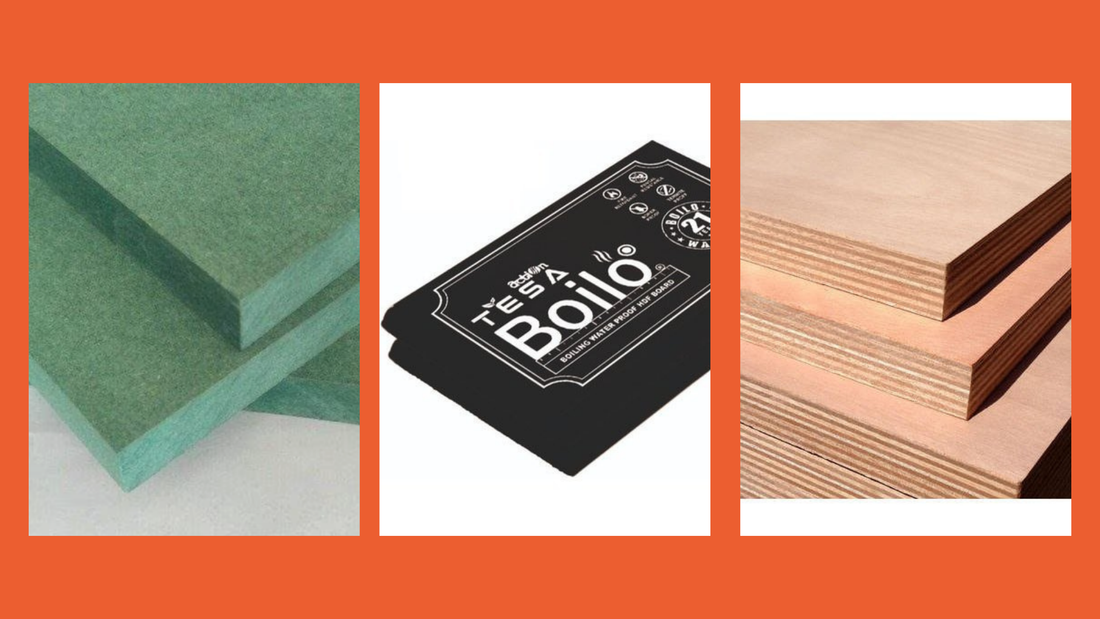
HDHMR vs BWP Plywood – Which One is Right for Your Space?
Share
When it comes to choosing plywood for your home improvement projects, particularly in moisture-prone areas like kitchens or bathrooms, deciding between HDHMR (High-Density High Moisture Resistant) board and BWP (Boiling Water Proof) plywood can be a bit overwhelming. Both materials offer distinct advantages, but understanding their strengths and limitations will help you make the best decision for your specific needs. Let’s take a closer look at each option and its suitability for different applications.
HDHMR Board: The Moisture-Resistant All-Rounder
HDHMR board is an engineered wood product designed to resist moisture while maintaining strength and durability. It's made with high-density fibers and moisture-resistant resins, making it ideal for areas that experience moderate moisture exposure.
Pros of HDHMR Board:
- Moderate Moisture Resistance: HDHMR board is perfect for spaces like kitchens, bathrooms, and interior furniture where moisture levels fluctuate but aren’t consistently high. It can handle steam from cooking or occasional water spills without significant damage.
- Affordable: Compared to BWP plywood, HDHMR board is more budget-friendly. This makes it an excellent option for projects where you need moisture resistance but don't want to invest in the higher cost of BWP plywood.
- Durability & Strength: The high-density fibers make HDHMR board resistant to warping and cracking, offering good durability for everyday furniture and cabinetry.
- Environmentally Friendly: Many manufacturers use sustainable practices to produce HDHMR boards, which is a plus for eco-conscious consumers.
- Smooth Surface: HDHMR Boards have a very smooth surface for acrylic laminates or Duco Paint finishes.
- Easy to Cut: HDHMR Boards can be used to create CNC designs with 3D engravings.
Cons of HDHMR Board:
- Not Suitable for Extreme Moisture: While HDHMR board is moisture-resistant, it doesn’t stand up to constant exposure to water or extreme humidity. For areas that experience high moisture levels continuously, such as bathrooms or outdoor furniture, BWP would be a better choice.
- Limited Structural Use: HDHMR board is ideal for furniture, cabinets, and non-structural applications. It may not have the strength needed for heavy-duty structural uses like flooring or formwork.

BWP Plywood: The Heavy-Duty, Water-Resistant Powerhouse
BWP plywood is specifically designed to withstand exposure to boiling water and heavy moisture, making it perfect for environments where moisture resistance is critical. It’s treated with phenolic resins that enhance its ability to resist water and prevent delamination.
Pros of BWP Plywood:
- Superior Moisture Resistance: As the name suggests, BWP plywood can handle boiling water without warping or degrading for 72 hours, making it the ideal choice for areas exposed to high levels of moisture, such as bathrooms, kitchens, and even outdoor furniture.
- Exceptional Durability: BWP plywood is waterproof, moisture proof, and resists fungal growth, ensuring that it will last even under extreme conditions. It’s also less likely to warp, crack, or delaminate over time compared to other types of plywood.
- Heavy-Duty Strength: This type of plywood is excellent for structural applications. It’s used in high-stress areas like flooring, formwork, and load-bearing applications, where you need strength and long-lasting durability.
- Versatile Applications: BWP plywood is also suitable for areas with direct water contact, such as boat interiors, outdoor furniture, or kitchens that are constantly exposed to moisture.
Cons of BWP Plywood:
- Higher Cost: Because of its superior moisture resistance and durability, BWP plywood comes at a premium price. It’s not as affordable as an HDHMR board, which can make it less appealing for projects that don’t require extreme moisture resistance.
- Overkill for Light Use: For light furniture or cabinetry where high moisture exposure isn’t a concern, BWP plywood may be overkill, and HDHMR board would be a more cost-effective and sufficient alternative.
- Finish Quality for Acrylic Laminates: BWP Plywood may not provide appealing surface finish quality for Acrylic Laminates & High Gloss Laminates

Pro Tip: Choosing the Right Plywood for Your Needs
When selecting between HDHMR board and BWP plywood, here’s a quick guide to help you decide:
- Choose HDHMR board if your project involves interior furniture, cabinets, or spaces like kitchens and bathrooms with occasional moisture exposure. It offers great value for money while providing the necessary moisture resistance. Opt for HDHMR Boards if the surface finish is acrylic or High Gloss Laminates.
- Opt for BWP plywood if you're working on projects that require extreme moisture resistance, such as bathrooms, flooring, or outdoor furniture. It’s also the ideal choice for structural applications that demand strength and durability. BWP Plywood is suitable for Matte Laminates & Suede Finish Laminates.
Action Tesa Boilo: A New Era of Moisture-Resistant Plywood
In addition to the traditional HDHMR board and BWP plywood options, there are newer introductions in the market, such as Action Tesa’s Boilo range, which offer a very high water resistance and durability, along with surface finish benefits of HDHMR Boards, bridging the gap between HDHMR board and BWP plywood.
Pros of Action Tesa Boilo:
- Advanced Moisture Resistance: The Boilo range provides excellent moisture resistance, making it perfect for kitchens, bathrooms, and areas with high humidity levels.
- High Durability: Boilo plywood is designed to withstand the test of time, offering superior resistance to warping, cracking, and damage from moisture.
- Environmentally Conscious: Like many modern plywood brands, Action Tesa focuses on eco-friendly manufacturing, making Boilo a sustainable choice for environmentally conscious buyers.
- Warranty : Comes with 21 years of warranty.
Cons of Action Tesa Boilo:
- Higher Cost: While Boilo offers a balance between HDHMR board and BWP plywood, it comes at a higher price point than regular HDHMR board, though it’s often more affordable than premium BWP plywood.
- Best for Moderate to High Moisture Areas: It’s a great choice for spaces with moderate moisture exposure but may not be necessary for environments with extreme water exposure where BWP plywood is the better option.

Conclusion
Choosing between HDHMR board and BWP plywood ultimately depends on your project’s moisture requirements and budget. HDHMR board is an excellent option for areas with moderate moisture exposure, while BWP plywood is your go-to choice for extreme moisture conditions and structural applications. For those who need something in between, Action Tesa Boilo offers a fantastic middle ground.
At Kyzo, we offer a variety of high-quality plywood options to meet your needs. Whether you need HDHMR board, BWP plywood, or innovative solutions like Boilo, we’ve got you covered. Contact us today to find the perfect material for your next project!



